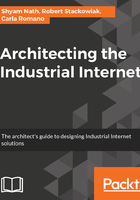
Architectural framework
Architectural framework IIoT systems comprise connected systems of machines, or industrial systems, exchanging data, analysis, and actions to improve production and performance, and reduce defects or failures. Vast quantities of data are collected, analyzed, and transmitted at a rapid rate to consuming systems or components, where further analysis and actions may occur. An architectural framework therefore becomes necessary to guide the design of the system and ensure all stakeholders' expectations are considered. Specific concerns of each stakeholder are described and organized into appropriate types of models (model kind). The various model kinds of each viewpoint are consolidated and organized, while resolving concerns, into an architectural view for the respective viewpoints. The architectural views of the various viewpoints in turn form the architecture framework:

As there are many factors for system architects to consider, it is useful to follow a common framework to organize topics of interest (concerns) and further the clarification, analysis, and resolution of concerns. A common framework such as the Industrial Internet Reference Architecture (IIRA), as published by the IIC in the paper The Industrial Internet of Things Volume G1: Reference Architecture (IIC:PUB:G1:V1.80:20170131), can provide a basis for this analysis, and the systems architects can expand upon it with their specific requirements. This standards-based reference architecture defines a common vocabulary and definitions, and can aid in the evaluation and resolution of concerns. It eventually guides the development of the IIoT system, and provides a reference for subsequent communications and documentation.